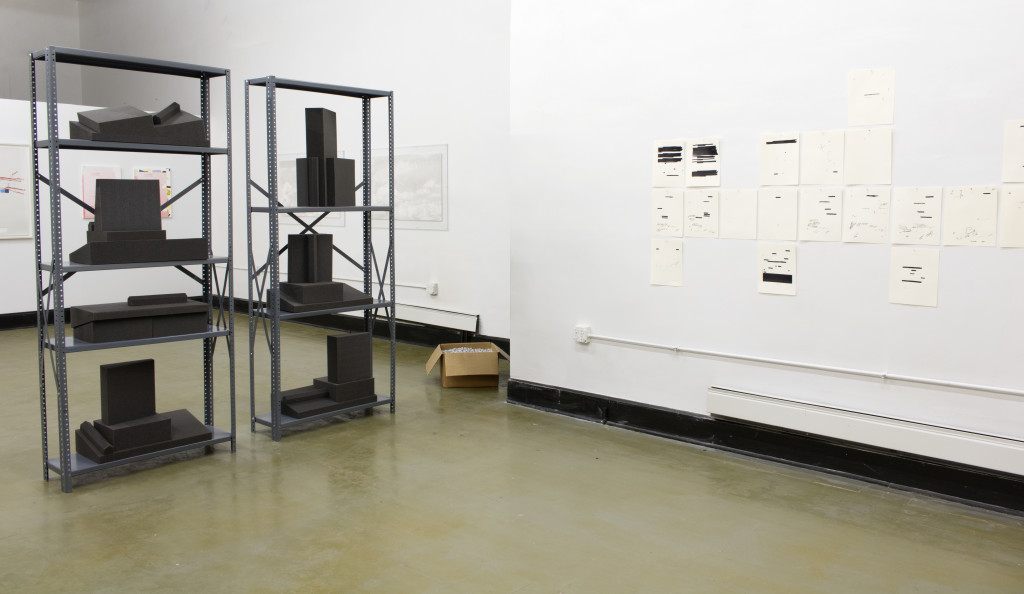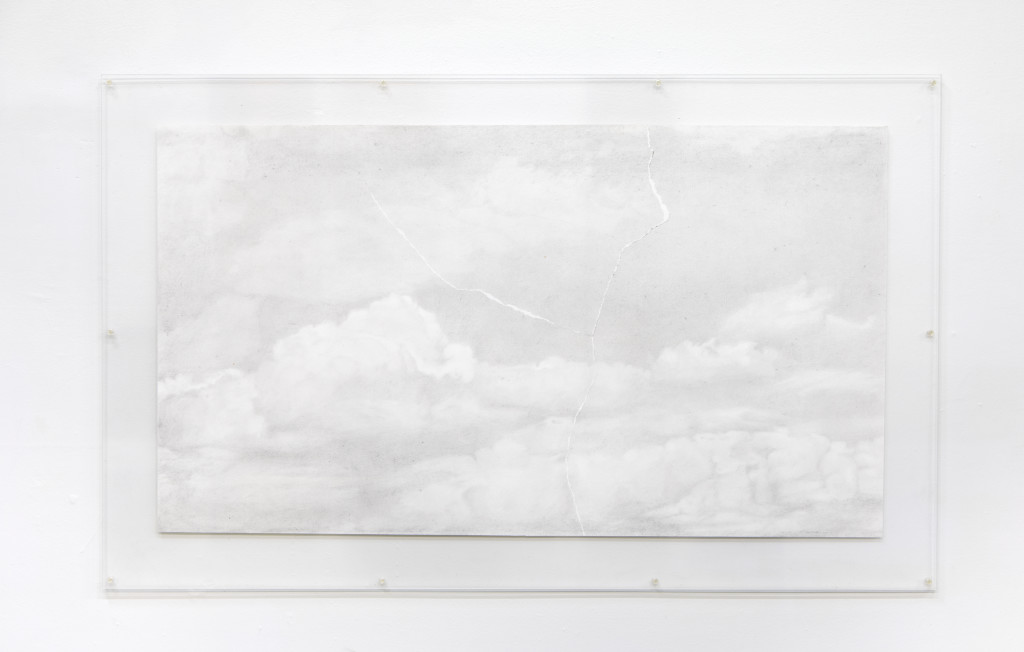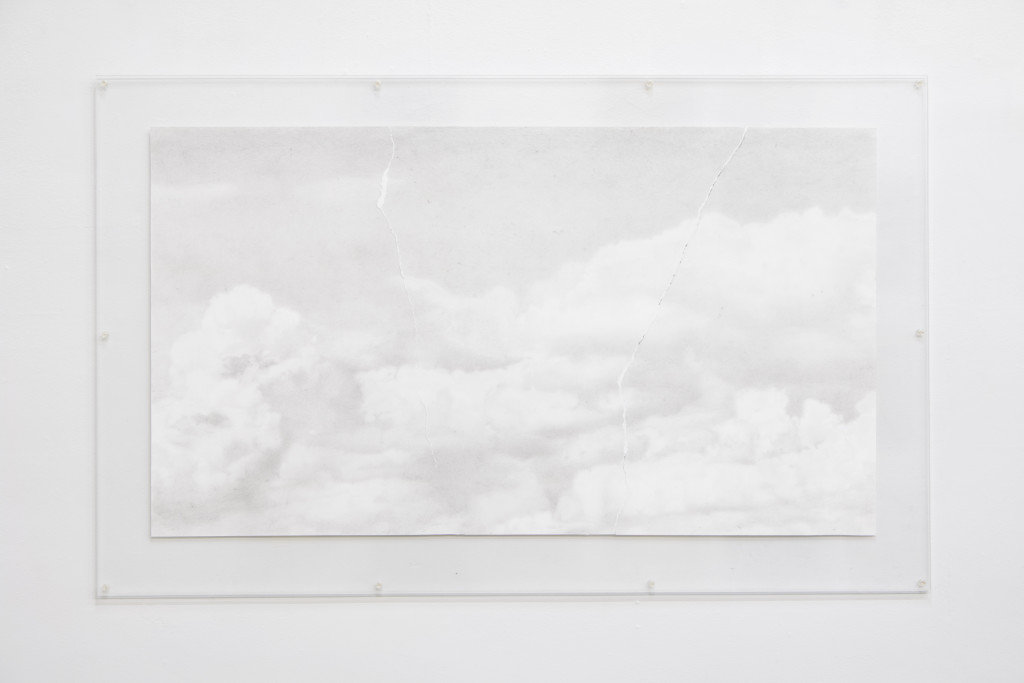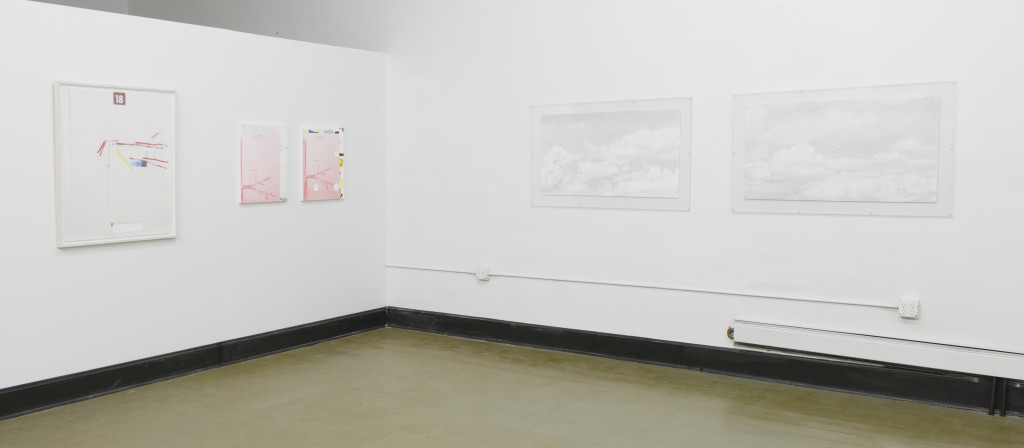Greg Bae: Triumph Gallery
by Ruslana Lichtzier
In 2014, artist Greg Bae returned to the Unites States after eighteen months in South Korea. His homecoming germinated a fixation on his last days there. In a closed circuit, his mind rebounded to the final memories in that country. One of them was watching the 1993 film “Groundhog Day.” The movie became for him a metaphoric apparatus, the sense of being encased within the moving picture, the recurrence of a single day, yet not only. The content of the film itself, each time it is experienced, is too part of the same encounter, time and time again. If time had stopped, the constantly morphing sky would hold still and become the opportune subject of a drawing. Indeed, this is the departure for Bae’s works, included in DOOR, a group exhibition curated by Ruslana Lichtzier and Ryan Coffey at Triumph in Chicago. The diptych drawings, entitled The Blackhole of Love (2017)—its title taken from the mis-translation of the film in Korean—are delicately modeled in smooth un-contrasting graphite, depicting the sky in the film’s opening sequence. Encased between two acrylic sheets, the drawings are preserved, though preemptively damaged—a tear in the paper runs across the surface, dissecting the clouds. A transcription of the conversation is below.

RUSLANA LICHTZIER: You took a giant leap with your work two years ago.
GREG BAE: Yes—it was when I went to Korea to do some residencies.
RL: Right. Before that, you were doing installation-drawing.
GB: Yeah. Essentially, I think of it as painting.
RL: Then, to put it simply, you transitioned to becoming more conceptually oriented, meaning your mediums shifted depending on the project—
GB: Yes, though it did not feel like I was just dropping everything and then starting something else. The work that you are talking about prior to this leap developed when I was in grad school. There, I tried to investigate painting on a formal level and go with it as far as I could, which led to that body of work. But, there’s always this nagging question about what your work is going to be about. When I went to Korea, I could slow down. There, content got a lot more attention and I became much more specific with content for grounding work rather than it being form.
RYAN COFFEY: What’s ‘about’ about?
GB: What’s about about?
RC: I mean, what does that mean? The thing is ‘about’ something, because everything is about something—if you categorize it and say something specifically about it. I mean, everything is specifically, and not specifically, about nothing or about something.
GB: All right, all right. Slow down, slow down. Yes, that is true. I am sure that a thing could take all sorts of interpretations once it leaves your studio. I am talking about a way of making decisions as an artist. Before, you could take anything and because something will always mean something, anything will always mean something, you can just use it and…you know, something will happen. There was not that much responsibility, that is what I mean. In Korea, I tried to make works that were much more specific. They were paired down in decisions, and the decision had much more intention. Does that make sense? I don’t know.
RL: The real question that I think we are all grappling with is the presumed division between content and form.
RC: When you say “content” and “form,” what you are really saying is it is about something or not about something else.
GB: Right, I am not sure if the division between these two ideas is a construction. Sure, it has been historically, at least in painting. There is a type of knowing, and a type of learning, that you do when you are just playing with materials. Then, the form becomes a content, and you have all sorts of abstract meanings that you can have. But that is a different way of operating from when you take an experience or a concept that you want to express. When you put concepts forward, you must be flexible and skilled with form, to put it to use to something that is not itself. It is the best when they are synthesized and become one and the same. That is when it is golden. I am trying to achieve that, I am trying to be really good at both and have them be the same thing, but not in the same way.

RC: I don’t think they are separate. I think that we’ve started in the mid-20th century separating things in a kind of heavy-handed didacticism of there is concept and then there is form, when really, they are of one and the same.
GB: Yes—when you start breaking them down, they become so vague and they merge. I don’t know, I mean, dividing the two is actually useful in how you organize your thoughts and how you categorize the ways you think. The trick is to be lucid. They are really at work, weave in and out, till they become appropriate. For me, it is actually harder to have an idea, to have something to make work “about” so to speak—it is a lot more difficult to have something that is worth trying to communicate. We do not always have ideas. I mean, you have ideas all the time, but which ones are really worth it? Form can lead to ideas, that is why I experiment a lot in the studio without thinking about what I am actually going to express, but that can go down a lot of different avenues. It is more difficult to come up with an actual idea.
RL: It is funny, I was thinking recently about this in a text I wrote. It’s a text, like, text has to have what it’s about. Text is this ‘about’—it is an unavoidably about something—but I did not know what it was about for a very long time. So, I worked through the text, as you work with matter. In that sense, you are playing with it and testing it out, and you are testing yourself, as if asking: what am I saying, what am I thinking?
RC: It is like there is a vague notion of a story that starts to inform itself to the writer. It sounds like you start with an idea, and then the idea starts to become you—
GB: Exactly, so just in response to both of you—first of all, yes. What the work is about, what it means to different people, the way that it is interpreted, there are probably at least four or five interpretations that can come off of the things that I make, but this is exactly the way that helps me to make decisions in the studio. You might not know what you are going to exactly do, but if you have a concrete direction that can help inspire and parse out the many options you could take, that is more or less what I am talking about, what you just said. I think the best thing to do is to keep talking and eventually, something slips through, which you are able to observe. I still believe in that process—
RL: What do you mean “keep talking,” with whom?
GB: Talking, [conversing, corresponding] as in you keep making stuff. You keep doing something that you do not know, in the hopes that something will emerge. I trust that process. But then there is the other side, where at a certain point when you keep talking and you actually do not like what you are saying—or maybe you have gone down a road for a little while, and realize, “Okay, well this actually is not really that fun anymore because a lot of surprise is gone, a lot of discovery is gone.” Then you find ways to push it. So, you push the form, do installations, whatever, you play with materials that you normally would not, so on and so forth, and then you keep going. Then after a while, you say, “Okay, so I am learning this thing that people call a language, but what is it good for until you actually have something to say?” That to me feels like a mature moment. It is like… what’s the analogy, like batman, he’s got a belt with all these weapons, right, but he needs a crime to fight, he needs a back story. What good is a belt by itself?
RC: I have an image from our first conversation about this body of work when we were at your place before any of this happened. You were talking about the airport, I have a very rich image in my mind of that with regards to this body of work. I can see it as kind of a starting point. I liked the work before you mentioned that. But then I was like, “Oh wow,” the work became more layered, very personal.
GB: Yes, during your visit to my studio, we were talking about an experience that was very real but also abstract. It was a significant moment for me, and I challenged myself to take it, refine it, and execute it in the studio—to actually make something “about.”
RC: Well, that is one of the things that I love about this movie that you are working in relation to, “Groundhog Day.” It is not about falling in love, it is not about becoming a better person. It is about the experience of being a human.
GB: Yeah, I mean there is a great parallel in the plot, with exactly what we are talking about, because the character lives his day over and over and over again—so he must ask himself then, “What do I do with my life? What do I actually do with all these experiences and all this stuff that I can do? What is the point?”
RL: One thing I really love about this work is the emotional spectrum it gives the viewer. I truly enjoy it. I like its dry sense of humor but you are not doing it here and that is one of the things I really enjoy. You are and you are not.
GB: I am glad that you picked up on that, because I worked really hard to hit the right kind of tone and key in terms of—this is going to sound really abstract but hopefully you know what I’m talking about—the atmosphere of the concept.
RL: Of course, 100%. I feel like this is a romantic work and it is a great romantic work. It hits both the sublime and the ridicule—it touches extremes. It is like the thing that you are actually ashamed about. It hits this spectrum, but then the highest note is the flat middle. What I really enjoy about this work is that, first of all, it absolutely seduces you. I love that you allow us to be seduced by something that is so romantic. Then it breaks us down.

RC: I see you sitting inside of this moment of love and doubt and confusion and timelessness and depression. Sitting in it, and not identifying with the pain, but instead sitting inside the mundanity of existence and pain. And you just keep doing it, drawing the clouds, when there is a way out, like to go and repent. Are you Catholic?
GB: I was raised Catholic, yes.
RC: Ok, so you can go to confession and be absolved immediately within the tenets of that religion. So, the people that actually flagellate themselves are sitting inside of their sin. and not identifying with anything really. Not that your work is saying that, but there is like a timelessness inside of that when you could be absolved. You could do these drawing quicker but you decided not to.
GB: That is exactly it. We are talking about hitting the right note. Right, “timeless” to me is the core of this body of work. Not timeless as in “lasts forever,” but as a literal investigation of the nature of passing time, how it affects you on an individual level. It’s something you can’t escape, it is totally futile to try. Most people have had this thought of, “Oh what if time could stop?” It is a pretty benign idea but it can be a real feeling. Sitting there, and taking the option to render this very slowly, is an indulgence. I can see how it might align itself in a metaphorical way to flagellation.
RC: And time itself is relative, right? That’s what I love with the clock pieces. It is like you are choosing to look at a moment as a continuum, like through that point at the airport that is still continuing. That’s probably more true than the point actually ending, because our mind is still processing information.
GB: If your mind is occupied it’s more important than the actual physical space that you are in. Is that what you are saying?
RC: Yeah.
GB: Sure, absolutely.
RC: I was listening to someone today in a podcast where somebody was saying that when you drive somewhere for the first time it seems like it takes forever.
GB: It is true.
RC: Then when you drive back and you’re like, “Oh that is 20 minutes.”
GB: Because you are recognizing the way, so it goes faster, you are not taking in so much information. I experience that too. I know what you are talking about.
RC: Time is always this amorphous thing. In relation to and kind of changing a little bit from what this flagellation thing is, we did not have to go that far into that, but it makes you think of this body of work as one that could definitely be viewed through the lens of, like, a Buddhist protest.
GB: Yes, and we have talked about Buddhism, you and me.
RC: I am interested in it in relation to the title of the movie “Groundhog Day” being translated to “The Black Hole of Love” in Korea—Korea versus America. And, then the fact that Catholicism exists in both these countries and Buddhism, and then the interpretation of Buddhism in America and the historical notion of Buddhism in Korea. All of these multiple identities you inhabit probably.
GB: My dad’s side of the family is Buddhist, and my mom is super Catholic—so I was raised Catholic, but whenever I visited my dad’s family, there were a lot of Buddhist influences.

RC: “The Black Hole of Love” sounds Catholic.
GB: You are right, it does I didn’t think of it that way but it definitely sounds like it.
RC: In America “Groundhog Day” is Buddhist. But then the interpretation in Korea to “The Black Hole of Love” is super Catholic.
GB: That is weird. I definitely never thought about it that way. That is new to me. I will have to think about that for a second—that’s really funny!
RC: I was not trying to have a conversation about theology. What is interesting around what I have been thinking about when we were talking…this is a weird conversation. I mean that is why we are doing it this way, is to expose the weirdness of what making is.
RL: To expose the fragility.
RC: Yes, and to make it lucid rather than, us emailing you 15 questions and then you give us the right answers that you are comfortable with.
GB: I have respect for each of you, and how you think.
RL: The conversation is being defined through intimacy and openness. I think that is the strength of it—to put it into context, we got a lot of feedback in relation to the previous conversation we published. One thing that was really important to both of us, is that people said that they do not read texts like this often, ‘this’ being the openness on all sides.
RC: And awkwardness.
GB: Awkwardness—like it being more natural and awkward at the same time?
RL: Exactly, for us it is really important, because I think it gives artists more room. Discourses often do not have enough room, but artists are good at molding themselves to a specific discourse.
RC: We’ve been taught to do that. We’ve been trained.
RL: Yes, and this conversation aims to give a space that is open to actually be “about,” and part of, the artistic practices, that are vast. So, we are not trying to actually hold it at all.
DOOR, the group exhibition of Dan Devening, Greg Bae, Jeff Prokash and Anna Shteynshleyger ran at Triumph Gallery from February 24–March 26.